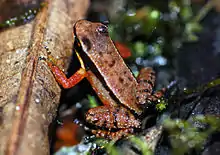Anomaloglossus kaiei
Anomaloglossus kaiei is a species of frogs in the family Aromobatidae, sometimes known as the Kaie rock frog. It is endemic to Guyana where it is known from the Kaieteur National Park and the Pacaraima Mountains.[2][4] However, as it is found along the Guyana–Brazil border, it is also possibly present in Brazil.[1] This frog shows maternal care: female frogs can provide tadpoles with trophic eggs.[3]
| Anomaloglossus kaiei | |
|---|---|
 | |
| Scientific classification | |
| Kingdom: | Animalia |
| Phylum: | Chordata |
| Class: | Amphibia |
| Order: | Anura |
| Family: | Aromobatidae |
| Genus: | Anomaloglossus |
| Species: | A. kaiei |
| Binomial name | |
| Anomaloglossus kaiei | |
| Synonyms | |
|
Colostethus kaiei Kok, Sambhu, Roopsind, Lenglet, and Bourne, 2006[3] | |
Description
Anomaloglossus kaiei are relatively small frogs with males attaining maximum snout–vent length of about 19 mm (0.75 in) and females 20 mm (0.79 in). In addition to the small difference in size, males differ from females in colouration, for example by having a cream-coloured belly (versus orangish yellow in females) and a light pink throat dotted with melanophores (pure orangish yellow in females). However, overall colouration is cryptic. Tadpoles are up to 17 mm (0.67 in) in length.[3]
Reproduction
Males are territorial and can be observed calling from on the ground or from elevated sites (e.g., boulders), mostly in morning and after rains. Courtship and ovipositioning behaviours are unknown. However, a male carrying a tadpole has been recorded (a common behaviour among aromobatids[5]). Furthermore, females of this species can provide the tadpoles with trophic eggs. This appears to be a supplement rather than an essential part of their nutrition. Nevertheless, this behaviour probably allows the tadpoles to speed up their development (advantageous in presence of predators or if there is a risk of desiccation), and may lessen cannibalism among the tadpoles.[3]
Habitat
Anomaloglossus kaiei is mainly known from primary forest, and to lesser extent from disturbed forest, with one specimen found at the savanna edge. It is a terrestrial, diurnal frog, without close association with bodies of water.[1][3]
References
- IUCN SSC Amphibian Specialist Group. 2018. Anomaloglossus kaiei. The IUCN Red List of Threatened Species 2018: e.T135874A120129553. https://dx.doi.org/10.2305/IUCN.UK.2018-1.RLTS.T135874A120129553.en. Downloaded on 21 December 2018.
- Frost, Darrel R. (2014). "Anomaloglossus kaiei (Kok, Sambhu, Roopsind, Lenglet, and Bourne, 2006)". Amphibian Species of the World: an Online Reference. Version 6.0. American Museum of Natural History. Retrieved 30 August 2014.
- Kok, P. J. R.; H. Sambhu; I. Roopsind; G. L. Lenglet; G. R. Bourne (2006). "A new species of Colostethus (Anura: Dendrobatidae) with maternal care from Kaieteur National Park, Guyana" (PDF). Zootaxa. 1238: 35–61. doi:10.11646/zootaxa.1238.1.3.
- Cole, C. J.; Townsend, C. R.; Reynolds, R. P.; MacCulloch, R. D.; Lathrop, A. (2013). "Amphibians and reptiles of Guyana, South America: Illustrated keys, annotated species accounts, and a biogeographic synopsis". Proceedings of the Biological Society of Washington. 125 (4): 317–578. doi:10.2988/0006-324X-125.4.317.
- Vitt, Laurie J.; Caldwell, Janalee P. (2014). Herpetology: An Introductory Biology of Amphibians and Reptiles (4th ed.). Academic Press. pp. 486–488.
